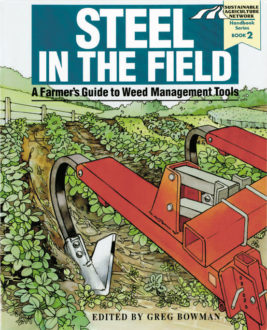Agronomic Row Crops
Cultivators
Innovations in the past 30 years have made cultivators more farmer-friendly, crop sensitive and soil-conserving compared with earlier models. Consider
Three-point hitch, front or rear mounts. If you remember cumbersome mid-tractor 'belly' mount corn cultivators, today's models are a lot less hassle. Rear three-point hitches are standard. Quick-hitches make connecting and dropping off cultivators as easy as backing up, making contact, and locking on. Front-mount three-point hitches give clean visibility and quicker steering response.
Soil-conserving designs. Flexing linkages, residue-cutting coulters, wide undercutting sweeps, greater clearance between components, narrow-profile shanks, and tall box crop shields have moved cultivation into high-residue, no-till systems. These components retain 50 to 90 percent of residue and minimize soil disruption in conservation tillage fields.
Precision and control. Stronger toolbars and attachments that are more rigidly secured serve to reduce the 'wobble factor,' allowing operators to run tools within 3 inches of crops at high speed, a feat that demands tight conformity front to back. Tool gang members - mounting frames set at right angles to the main toolbar - can hold a set of tools that work between rows. Most are attached to the toolbars by parallel linkage - assemblies of pins, hinges and springs that consistently keep each sweep moving independently at its desired depth in uneven terrain. A range of guidance systems can provide constant tool alignment without a backward glance. They are described here after row-crop tools.
Adjustment. A generation of farmers with skinned knuckles prompted the 'wrenchless adjustment' cultivators, cranked screw-jack depth controls, single wrench systems, spring-pin adjustments and re-positioning of adjusting nuts in more accessible locations.
Crops, soils, weed species and tillage all influence the tooling of a cultivator and what it needs to do to manage weeds. This book presents four general cultivator types, categorized by their capacity to handle crop residue. Groups are titled 'low residue,' for conventional and reduced tillage that leaves up to 20 percent residue; 'moderate residue' for up to 30 percent residue; 'high residue' for up to 60 percent residue with minimum tillage of 120-160 bu/A corn; and 'maximum residue' for 90 percent residue or more with no tillage of highest-yielding corn. Categories are further defined in each entry.
Cultivating loose, residue-free soils is the forte of multi-sweep vibrating S-tine units. These tines shake weed roots free from clinging soil. In firmer soils that resist sweep movement or in higher residue levels that plug close-set shanks, rigid single shank cultivators pull sharp sweeps that slice weeds just beneath the soil surface. Sweep profile, design style and wing angle determine whether soil is lifted unbroken, turned over, or moved into the row. Rolling cultivators are highly adjustable, aggressive, soil-stirring tools that can handle moderate residue and effectively work angled beds or flat fields.
| TIPS: Run coulters 0.5' to 1' below point of sweep to effectively cut residue. Use disk hillers (where residue allows) to cut weeds and push them away from the row, or (when crops are established) to throw soil back onto the row to smother small weeds. |
